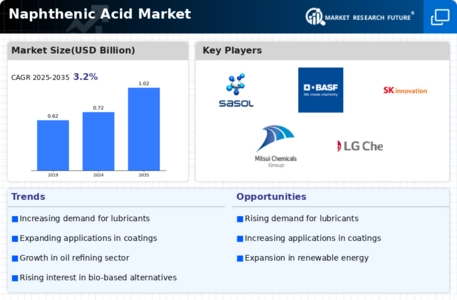Market Growth Projections
The Global Naphthenic Acid Market Industry is projected to experience substantial growth over the next decade. With an estimated market value of 0.72 USD Billion in 2024, the industry is expected to expand to approximately 1.02 USD Billion by 2035. This growth trajectory suggests a compound annual growth rate of 3.23% from 2025 to 2035, reflecting the increasing adoption of naphthenic acid across various applications. The market's expansion is likely driven by rising demand from end-use industries, technological advancements, and a focus on sustainability, indicating a promising outlook for stakeholders in the naphthenic acid sector.
Growing Environmental Regulations
The Global Naphthenic Acid Market Industry is increasingly influenced by stringent environmental regulations aimed at reducing the ecological impact of chemical manufacturing. Governments worldwide are implementing policies that encourage the use of eco-friendly alternatives, thereby driving the demand for naphthenic acid derived from sustainable sources. This shift is particularly evident in regions where regulatory frameworks promote the adoption of greener technologies. As industries adapt to these regulations, the market may experience a transition towards more sustainable practices, potentially enhancing the appeal of naphthenic acid as a compliant and environmentally responsible choice for manufacturers.
Expansion of the Automotive Sector
The automotive sector's expansion plays a pivotal role in shaping the Global Naphthenic Acid Market Industry. As vehicle production increases globally, the demand for high-quality lubricants and additives rises correspondingly. Naphthenic acid is integral to formulating lubricants that meet the stringent performance requirements of modern engines. This trend is particularly pronounced in emerging markets, where automotive production is on the rise. The anticipated growth in the automotive industry is expected to bolster the naphthenic acid market, with a projected compound annual growth rate of 3.23% from 2025 to 2035, indicating a robust future for this chemical compound.
Rising Demand from End-Use Industries
The Global Naphthenic Acid Market Industry experiences a notable surge in demand driven by various end-use sectors, particularly in the production of lubricants and surfactants. As industries increasingly seek high-performance products, naphthenic acid's unique properties make it a preferred choice. For instance, the lubricant segment is projected to witness substantial growth, contributing significantly to the market's expansion. The market is expected to reach approximately 0.72 USD Billion in 2024, reflecting a growing reliance on naphthenic acid in formulations that require enhanced stability and performance. This trend underscores the importance of naphthenic acid in meeting the evolving needs of diverse industrial applications.
Market Diversification and Product Innovation
The Global Naphthenic Acid Market Industry is witnessing a wave of diversification and product innovation as manufacturers seek to cater to a broader range of applications. This trend is characterized by the development of specialized naphthenic acid derivatives that enhance performance in specific applications, such as coatings, adhesives, and sealants. By expanding their product portfolios, companies can tap into new markets and meet the evolving demands of consumers. This strategic approach not only fosters competitiveness but also positions naphthenic acid as a versatile chemical in various industrial sectors, thereby contributing to the overall growth of the market.
Technological Advancements in Production Processes
Technological innovations in the production of naphthenic acid are poised to enhance efficiency and reduce costs within the Global Naphthenic Acid Market Industry. Advances in refining techniques and extraction methods enable manufacturers to produce higher purity naphthenic acid, which is essential for specialized applications. These improvements not only optimize yield but also align with sustainability goals by minimizing waste and energy consumption. As a result, the market is likely to benefit from increased production capacities and improved product quality. This technological evolution could potentially contribute to the market's growth trajectory, with projections indicating a rise to 1.02 USD Billion by 2035.















